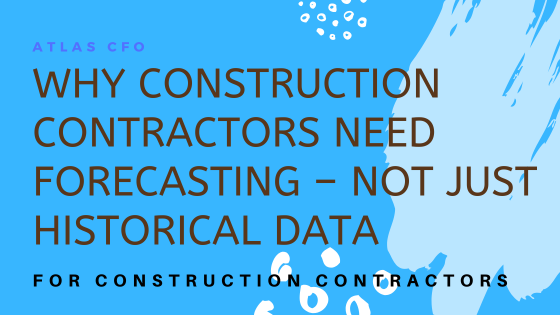If you’re running a construction company, chances are you’ve looked at your financial statements and asked:
“Okay… but what’s going to happen next?”
That’s the question financial forecasting answers. And it’s a game-changer for contractors who want to run a proactive business instead of a reactive one.
In this post, we’ll explore why historical data alone isn’t enough, what financial forecasting really is (and isn’t), and how it can help your company grow with less guesswork.
Historical Data: Helpful, but Only Part of the Picture
Your Balance Sheet, Income Statement, and WIP report are essential. They help you:
- See what happened last month
- Understand job profitability
- Analyze cash flow and overhead
- Build trust with outside partners like your bank or bonding agent
But here’s the catch:
Historical data is like looking in the rearview mirror. Forecasting turns on the headlights.
If you’re only reviewing what already happened, it’s almost impossible to:
- Adjust before it’s too late
- Make confident hiring or equipment decisions
- Prepare for seasonal dips or growth spikes
- Plan distributions, bonuses, or taxes
What Is Forecasting for Contractors?
Forecasting = Taking what you know today to project what’s likely to happen tomorrow.
In construction, a solid forecast combines:
- Current financials (Balance Sheet + Income Statement)
- Your Work-in-Progress schedule
- Your backlog of awarded but not-yet-complete jobs
- Overhead and staffing plans
- Revenue and cost assumptions
This allows you to project:
- Revenue and gross profit over the next 3, 6, or 12 months
- Cash flow trends and capital needs
- Whether you’ll hit (or miss) profit targets
- The financial strength of your Balance Sheet at year-end
Why Forecasting Is So Important in Construction
Unlike many industries, construction is:
- Project-based
- Cash-intensive
- Heavily reliant on external stakeholders (banks, bonding, etc.)
- Subject to revenue delays and unexpected costs
That means decisions you make today (hiring, bidding, buying) might not show up on your Income Statement for months.
Forecasting helps bridge the gap by showing you the likely future based on the contracts you’ve secured and the expenses you expect.
Examples of How Contractors Use Forecasting
- Decide whether to buy equipment or finance it
- Plan for new hires based on revenue outlook
- Calculate breakeven and overhead recovery
- Estimate tax liability before year-end
- Spot cash flow issues before they happen
- Present strong financials to bonding agents with a forward-looking view
One of our clients used their forecast to show their bank and surety how their year would finish. That helped secure a bigger bonding line—and the jobs that came with it.
Forecasting vs. Budgeting: What’s the Difference?
Budgeting is typically done once a year and sets the “ideal” plan.
Forecasting is updated regularly (monthly or quarterly) and reflects current reality.
Think of it like this:
- Budget = the plan
- Forecast = the actual path you’re walking
You need both. But forecasting is what keeps you from walking off a cliff.
Tools for Contractor Forecasting
If you’re still using spreadsheets (or nothing at all), forecasting might feel overwhelming.
That’s why we built the Atlas Growth Model — a projection tool built specifically for construction companies. It combines:
- Monthly financials
- WIP and backlog
- Overhead and revenue assumptions
- Built-in KPIs and benchmarking
- Bonding-focused insights
You can use it with our team (Done-With-You), or DIY with training and setup.
Ready to Move from Rear-View to Forward-Facing?
Historical data tells you where you’ve been.
Forecasting tells you what’s coming—and what to do about it.
Contractors who forecast:
- Make better decisions faster
- Manage risk more confidently
- Sleep better at night (yes, really)
Whether you’re leading a $5M company or a $50M operation, forecasting puts you in the driver’s seat.

